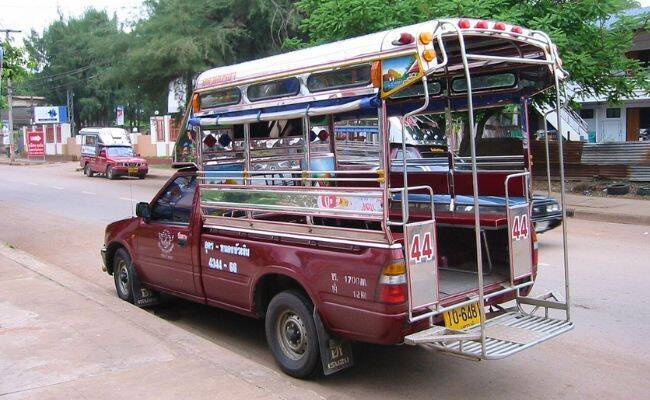The songthaew (สองแถว) is a ubiquitous sight on the roadsides and city streets of Thailand. With a literal meaning of “two rows”, the public truck derives its name from the two bench seats fixed along each side of the truck bed. In some variations, a third bench runs down the middle.
Also known as a Baht bus (due to its affordable service) in some tourist areas such as Pattaya, the songthaew features a roof at the rear, often with curtains and plastic sheeting for rain protection. Some models have high roofs allowing standing passengers inside, while others use a rear platform.
Within cities, songthaews are typically converted from pickup trucks, following fixed routes for a standard fare. In certain places they function as shared taxis, accommodating passengers heading in similar directions, thereby offering flexible and cost-effective transportation options for local commuters.
In some areas of Thailand such as Chiang Mai, locals refer to songthaews as “rot si daeng” (literally “red car”), “rot daeng,” or sometimes “si rot.”

History and Evolution
Vehicles
Songthaews were first introduced to Thailand during the 1950s, initially based on Austin A30 sedans. By the 1960s, they began incorporating British models such as the Leyland 15/20, Morris 250 JU, Morris J4, and Morris Minor. In the 1970s, songthaews transitioned to utilising a variety of models, including the Mercedes-Benz T2.
Songthaews now include models like the Isuzu Faster and Toyota Hilux. Other variants, such as the Daihatsu Hijet, Subaru Sambar, and Suzuki Carry, are known as “rot ka-poh” (literally “toad cars”), named for their shape. They are also called “rot kra-pong” (“tincan cars”) or “rot-Subaru” (“Subaru cars”), referencing their brand.
Culture
Songthaews have a rich history deeply intertwined with Thailand's cultural and transportation landscape. Originating as modified trucks or pickups, these vehicles were initially used for transporting goods and people between villages. Over time, locals began using them for passenger transport, adapting the vehicles with seating and roof coverings for protection from the elements.
Community
Songthaews are indispensable for enhancing mobility and improving quality of life for those on limited financial resources, playing a vital role in the socio-economic fabric of local communities.
For low-income families, songthaews offer an affordable means to commute to work, ensuring they can reach their workplaces reliably and economically. These vehicles also facilitate access to education by transporting students to schools and universities, contributing significantly to educational opportunities for families who may otherwise struggle with transportation costs.
Pros & Cons of Using Songthaews
For expats, tourists and locals alike, there are a number of pros and cons to using this mode of transport.
Pros:
- Affordability: Songthaews are among the most economical modes of transport in Thailand, with fares often lower than those of taxis or private cars.
- Flexibility: They operate on fixed routes but can also be hailed for shorter distances or special trips, making them convenient when exploring local attractions.
- Local Experience: Riding a songthaew provides an authentic glimpse into everyday Thai life, as you share the journey with locals going about their daily routines. They also go pretty slow, giving you a chance to take in the sights as you travel.
- Accessibility: They reach areas not serviced by larger buses or trains, making them essential for transportation in rural and less developed areas.
Cons:
- Limited Routes and Schedules: Songthaews typically operate on fixed routes and schedules, which may not always align with your specific time and destination.
- Safety: Songthaews lack modern safety features such as seatbelts and air bags, and the open-air design offers minimal protection from weather conditions and road pollution.
- Language Barrier: Communication with drivers may be challenging for non-Thai speakers, potentially leading to misunderstandings about fares or destinations.
- Overcrowding: During peak times, songthaews can become crowded, leading to some passengers dangerously clinging on while squashed in and standing up.
In Summary
Songthaews represent more than just a mode of transport in Thailand; they embody a unique blend of tradition, practicality and community spirit. Whether navigating bustling city streets or winding rural roads, these colorful vehicles offer travelers a chance to travel like the locals.
However, they aren't the safest mode of transport because of the lack of safety features and their open-air style. Personally, I use a songthaew once in a while, often when visiting a new province, but I don't make regular use of them, and certainly not in cities like Bangkok and Chiang Mai where the traffic congestion causes very bad air quality.
This protects you against illness, injury, theft, and cancellations. I never travel without it. I’ve been using SafetyWing for years. You should too. Best hotel rates are found at Agoda and Hotels.com. Check out this guide for the best options.Tips to Start Planning Your Trip Now:
Don’t Forget Travel-Medical Insurance
Book Your Accommodation
Considering a Backpack?
Last Updated on



HA Hobson says
Wonderful article
Aug 13, 2024 at 9:45 am
TheThailandLife says
Aug 14, 2024 at 12:00 am
Joakim (โยอาคิม) Gasslander says
Lovely written article about Songthaews and a bit of important deep culture described in a beautiful way.
Let me contribute with a couple of THB.
I have Krungsri bank account and let me know your preferred way for me to make a small contribution.
🙏
Jul 24, 2024 at 9:15 am
TheThailandLife says
Jul 24, 2024 at 3:35 pm
Munnster says
Jul 24, 2024 at 7:49 am
TheThailandLife says
Jul 24, 2024 at 3:33 pm